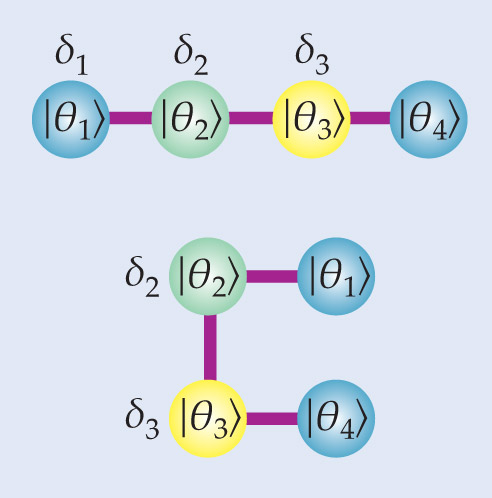A blind quantum computer makes its laboratory debut
DOI: 10.1063/PT.3.1464
Described by Vlatko Vedral of the University of Oxford as “possibly the most exciting idea in quantum computing in the last 10 years,” blind quantum computing would enable a client, who herself has no quantum computing capability, to run an algorithm on a remote server without revealing anything about her input, computation, or output. Now, Philip Walther (University of Vienna) and colleagues have demonstrated a small-scale version of a blind quantum computer. 1
The experiment used a protocol 2 presented in 2009 by Anne Broadbent (University of Waterloo, Canada), Joseph Fitzsimons (then also at Waterloo, now at the National University of Singapore), and Elham Kashefi (University of Edinburgh). Broadbent and collaborators based their scheme on a so-called one-way quantum computer: Rather than manipulating a system of qubits and then reading out the result, the computer starts with a highly entangled state, universal for all computations up to a certain size, and performs a series of single-qubit measurements. The results of those measurements can then be processed with a classical computer to give the computation output. To make the computation blind, Broadbent and company have the client prepare the qubits with phase angles θi that only she knows and have her instruct the computer to measure them at angles δi. The computer entangles the qubits in a specified way, measures them, and transmits the results back to the client. Without knowing the angles θi, neither the computer nor an eavesdropper can deduce the underlying computation from the angles δi and the measurement results.
In contrast to previously proposed schemes for blind quantum computation, Broadbent and company’s protocol doesn’t require the client to do anything that’s not well within the bounds of present-day technology. Even the tasks required on the computer’s side—entangling the qubits pairwise and measuring them one by one—can be carried out on small systems, as Walther and colleagues have now done. The Walther group’s computer used four qubits, which took the form of photons. Not much computing can be done on a one-way quantum computer of that size, but the researchers successfully demonstrated various one- and two-qubit quantum logic gates, the eventual building blocks of a larger quantum computation. They also carried out miniature versions of two algorithms, including a database search, that promise to be more efficient on a quantum computer than on a classical one. Along the way, they found that they could still achieve blindness without preparing all the qubits in states unknown to the computer: In their four-qubit system, it suffices to have just two qubits (θ2 and θ3, shown in yellow and green in the figure) in secret states. That discovery could make it easier to implement larger blind computations in the future.

A one-qubit gate (top) and a two-qubit gate (bottom) implemented on a four-qubit blind quantum computer. The qubits are prepared in initial states ∣θi〉, pairwise entangled as shown by the purple lines, and measured at angles δi in order from left to right (not necessarily numerical order). The rightmost qubits in each gate are the gate’s output; they could become another gate’s input in a larger computation. When θ2 and θ3 are kept secret, the computation is blind: Neither the computer nor an eavesdropper can deduce the underlying computation. (Adapted from ref.

References
1. S. Barz et al., Science 335, 303 (2012). https://doi.org/10.1126/science.1214707
2. A. Broadbent, J. Fitzsimons, E. Kashefi, in Proceedings of the 50th Annual Symposium on Foundations of Computer Science, IEEE Computer Society, Los Alamitos, CA (2009), p. 517; available at http://arxiv.org/abs/0807.4154.
More about the Authors
Johanna L. Miller. jmiller@aip.org




